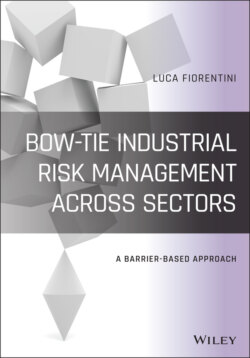Читать книгу Bow-Tie Industrial Risk Management Across Sectors - Luca Marmo, Luca Fiorentini - Страница 22
Author Preface
ОглавлениеLuca Fiorentini
Director, TECSA S.r.l.
Risk, as per the ISO 31000 international standard, is defined as “effect of uncertainty on objectives,” where the “effect is a deviation from the expected”: risk is “usually expressed in terms of risk sources, potential events, their consequences and their likelihood.”
When I first met the Bow‐Tie method many years ago I classified it as a simple, immediate, funny notation to describe simple situations. At that time I could refer to my experience in the industrial risk and process safety domains with HSE cases built with the use of multiple and combined methodologies (fault tree, event tree, HAZID/HAZOP/FMEA, etc.) up to full quantitative risk assessments based on calculations. So I started using Bow‐Ties to summarize the results coming from other methods, nothing more. Immediate (and coloured) notation of my Bow‐Ties started enriching my executive summaries, my papers, my conference slides, and so on with a great reward in terms of appreciation from readers, students, colleagues, and customers.
Later I realized that I had discovered one of the main capabilities of the method: the clarity power of notation. It happened during the preparation of my Italian book on fire risk assessment, in which I described a number of methods (also risk matrices, structured brainstorming, LOPA, etc.) and I decided to describe with a Bow‐Tie diagram a couple of real incidents: the Buncefield tank fire in the UK (from a description given by the UK Health and Safety Executive in an official report) and the Thyssenkrupp fire in Italy that became very famous for the number of fatalities (seven) and in which I was part of the technical consultant group working on behalf of the Public Prosecutor’s Office since the beginning of the investigations. Both of the two incidents, described with a Bow‐Tie, raised the usual interest and curiosity in the readers, but I did understand that Bow‐Tie is the best way to deal with the essence of the various elements that define risk according to the ISO 31000 standard: hazard, deviation, threats, and consequences.
Deviations are raised from threats and could lead to potential impacts in a very simple and straightforward path. This flow can be interrupted by barriers (or controls) that can modify the likelihood and or the severity of the consequences. Simple enough!
The diagram can be modified to include more details (failure mechanisms of barriers, common causes of failure, roles and responsibilities associated to each control in place, …), a quantification (escalation factors, conditional probabilities, conditional modifiers, vulnerabilities, …), a link among different diagrams, the real‐time status of the barriers in place, and also a simulated alternative that considers nice‐to‐have additional or modified controls – without losing the beautiful and clear overall picture that, at the end, could also be seen as a combination of a fault tree with an event tree, with the additional ability to conduct a LOPA on each threat‐consequence pair, conduct a cost‐benefit analysis on risk mitigation alternatives, associate probabilities derived from other calculations, investigate the failures of human‐centred barriers, and so on, with the ultimate ability to validate the barriers and calculate the risk over time and to improve risk assessment using the results of learning from experience.
These limitless possibilities of enrichment are offered even if we are guaranteed that the risk picture is visible and always available also to non‐technical parties, among them the stakeholders involved in risk‐based decisions. Focus should be given to barriers over time and this process can be referred to “risk management as all the coordinated activities to direct and control an organization with regard to risk,” whatever risk we should face to make decisions.
This book gives the reader my idea of the Bow‐Tie method and barrier‐based risk management as one of the best tools to deal with current complexity with a structured and consistent approach that allows for value protection and creation inside organizations of all types and sizes facing internal and external factors, including human behaviour and cultural factors. The principles described with a Bow‐Tie diagram are those at the foundation of an effective and efficient risk management framework enabling an organization to deal with the effects of uncertainty on its objectives over time with a customized, integrated, yet dynamic approach based on the best available information. Complexity is increasing, day by day; let’s keep our Bow‐Ties simple and “smart.”
